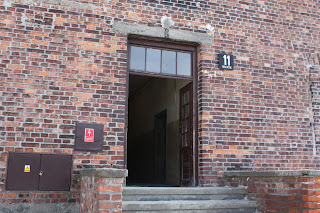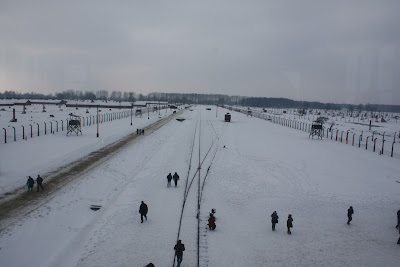 Consider what you see and hear around you, and use your voices to Speak Up against hatred and discrimination.
Consider what you see and hear around you, and use your voices to Speak Up against hatred and discrimination.
 |
| Arbeit Macht Frei "Work Brings Freedom" |
When I think of the Holocaust, the first thing that comes into my head is the number '6 million'. In all the books I've read and films I've watched about the holocaust, that number has stuck in my head. Such an enormous figure is hard to imagine when I think of it in terms of people - men, women and children. 6 million people murdered in concentration and extermination camps, ghettos and mass-shootings. Hitler's regime murdered Jews from countries all over Europe as well as physically and mentally disabled people, homosexuals, gypsies, political prisoners and those involved in resistance movements.
Why this day?
Holocaust Memorial Day takes place on 27th January because it was on this day in 1945 that Soviet soldiers liberated Auschwitz-Birkenau - the largest Nazi killing camp. Here, 1.1 million people were murdered. Holocaust Memorial Day is one day in the year when we can reflect on our lives and think about those 6 million people who lost their lives as a result of Nazi persecution. It is also a day when we can spare a thought for those who lost their lives or whose lives were altered forever in subsequent genocides in Cambodia, Rwanda, Bosnia and Darfur.
I visited Auschwitz during winter. I crunched around in the snow until I got to the gated entrance to Auschwitz where I felt quite awkward watching the sheer number of tourists about to embark on group tours. I immediately separated myself from them, trying to rid myself of the idea that Auschwitz was some kind of tourist attraction. But thinking about it now, I suppose it is. The fact that so many people come from all over the world daily to visit this 'attraction' shows us the enormous impact it has had the world over. Having seen it with my own eyes, I feel particularly strongly that everyone who has the means should visit Auschwitz or another Nazi camp at some point in their lives. Auschwitz I is a maze of camp blocks and barracks, all surrounded by barbed wire and overlooked by giant guard towers. It was originally a Polish military camp but when the Nazis came they turned it into a prisoners camp. Scull and cross bone signs dug into the ground threaten those who dare to wander too close to the barbed wire to 'Halt!' It was here that the first Auschwitz camps were opened and where they tested the lethal Zyklon-B (used in the gas chambers to kill people). It was also here where the Nazis conducted experiments on prisoners and carried out executions. Several of the blocks are open to the public and as you walk into each room you are surrounded by floor to ceiling huge collections of personal possessions from those who came to Auschwitz. Among the items were 3,800 suitcases, 40 kg of glasses and 110,000 shoes. One room held two tons of human hair. These rooms were probably the most moving and as you can imagine, it was an emotional experience.
 |
| Block 11 - The Death Block |
Block 11 was known as the 'Death Block'. It was here that prisoners suspected by the camp gestapo of carrying out clandestine activities were held (attempting to escape/organising mutinies/contact with outside world). They were generally brutally interrogated before being shot. For a time this block also held the Sonderkommando (the special unit of prisoners who were forced to burn bodies). Going down into the basement, I saw four standing punishment cells so small (1 square metre each) that it was hard not to visualise four prisoners confined in each cell for the night before having to go to work in the morning. The only source of air was a 5 x 5cm opening covered with a piece of metal. There were also dark cells which prisoners were confined to for days or even weeks, this was the way the SS put people to death by starvation. The SS carried out an experiment here with Zyklon-B which led to the mass killing of thousands of people in the gas chambers. Between 3-5th September in 1941 600 Soviet POWs and 250 Polish political prisoners were selected from the camp infirmary to act as guinea pigs.
 |
| 'Death Wall' in the walled-off yard of block 11 |
 |
| 'Death Wall' - It was here that a firing squad would shoot prisoners. |
 |
| Camp blocks |
 |
| Barbed wire fence |
"The first to perish were the children, abandoned orphans, The World's best, the bleak earth's brightest. These children from the orphanages might have been our comfort. From these sad, mute, bleak faces our new dawn might have risen"
(Auschwitz Birkenau)
A short bus or taxi ride away lies the remains of Auschwitz-Birkenau. At this camp, approximately one million European Jews were murdered. In 1944 over 100,000 prisoners (Jews, Poles, Roma and others) were here, housed in 300 wooden barracks. The camp holds the ruins of the gas chambers and crematoria. My experience here was somewhat different. It was a vast expanse of space (200 hectares of grounds), blanketed in thick snow from the bitter Polish winter. The cold seemed to penetrate through six layers of clothes and three pairs of socks to reach my bones. All I could think about was how perishing the cold was (-10), and how prisoners were made to walk around in freezing temperatures wearing next to nothing.
 |
| Auschwitz-Birkenau |
After a while, the people drift away, the coaches drive away and all that is left is the sound of the icy air whizzing past you and the feeling that you are not alone. It was eerie, bleak and when I realised I was the last person left, somewhat terrifying. However, though it may sound strange, it was one of the most peaceful moments in time I have ever experienced. It was pure stillness. Nothing moved, nothing sounded - not even the birds.
 |
"For ever let this place be a cry of despair. And a warning to humanity. Where the Nazis murdered about one a half million men, women and children, mainly Jews from various countries of Europe".
"I swore never to be silent whenever human beings endure suffering and humiliation. We must always take sides. Neutrality helps the oppressor, never the victim. Silence encourages the tormentor, never the tormented". Elie Wiesel, Holocaust survivor.







No comments:
Post a Comment
Feel free to leave a comment!